Listeriosis represents a serious invasive illness that predominantly affects pregnant women, newborns and immunocompromised individuals. Contaminated foods are vehicles used by the causative organism, Listeria monocytogenes, for its transmission to humans. Bigger and smaller outbreaks of listeriosis have been reported throughout the globe.
The public health significance of listeriosis is not adequately recognized, especially since it is considered rare in comparison to other foodborne diseases. Nonetheless, due to its severity and high mortality, listeriosis is considered as one of the most frequent causes of death when foodborne illnesses are concerned.
 Image Credit: Kateryna Kon / Shutterstock.com
Image Credit: Kateryna Kon / Shutterstock.com
Prevalence and incidence of the disease
Listeriosis has a low incidence rate and is reported almost exclusively in industrialized countries (data from Asia, Africa and South America is scarce). According to the CDC, it is estimated that in the US 1,600 people contract listeriosis each year and around 260 of these die.
A wide range of food products have been associated with the transmission of listeriosis, primarily milk and dairy products, meat products (cooked chicken, pâté, rillettes, sausages, salami), vegetables (coleslaw and rice salads, celery, alfalfa) and, in a lesser degree, fish products (smoked fish, shellfish, shrimp). Generally, these foods have extended shelf life, do not require further cooking and support the growth of the bacterium.
As of 2021, there is an outbreak of listeriosis due to Hispanic-style fresh and soft cheeses in the US. Over the last 10 years, there have been outbreaks in the US associated with a broad range of foods including cantaloupe melons, ice cream and frozen vegetables. Outbreaks have also occurred in Europe, the UK, South Africa, Australia and Spain over the last seven years.
Listeria monocytogenes most frequently associated with listeriosis cases belong to serotypes 1/2a, 1/2b, and 4b. Epidemiological monitoring studies employ different genotyping techniques, with pulse-field gel electrophoresis (PFGE) as the golden standard due to its discrimination and reproducibility for molecular sub-typing of this pathogen.
FSA Explains: Listeria
Risk groups
Medical advances and demographic changes have resulted in an increase in the size of certain at-risk groups for listeriosis, namely the elderly and immunocompromised patients. It must be noted that, even though listeriosis can cause disease in all populations, more than 50% of all cases occur in those older than 65 years of age.
In addition, certain groups within the general population that have an underlying condition that can lead to the impairment of T-cell-mediated immunity are particularly susceptible to this infection – namely immunocompromised individuals on certain medications (such as organ transplant patients) and HIV-infected individuals.
Listeriosis is approximately 18 times more common in pregnant women than in the general population. Furthermore, pregnant women account for 16-27% of all listeria infections, which can cause mild illness in mothers but can be devastating to the fetus, in some cases leading to severe disease or fetal death. The incidence of listeriosis in the newborn is estimated at a rate of 8.6 per 100,000 live births.
References
Further Reading
Last Updated: Feb 17, 2021